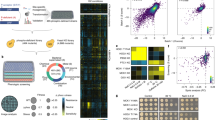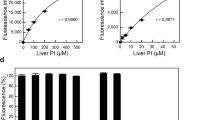Abstract
Soluble inositol polyphosphates are implicated in the regulation of many important cellular functions. This protocol to extract and separate inositol polyphosphates from Saccharomyces cerevisiae is divided into three steps: labeling of yeast, extraction of soluble inositol polyphosphates and chromatographic separation. Yeast cells are incubated with tritiated inositol, which is taken up and metabolized into different phosphorylated forms. Soluble inositol polyphosphates are then acid-extracted and fractionated by high-performance liquid chromatography. The radioactivity of each fraction is determined by scintillation counting. This highly sensitive and reproducible method allows the accurate detection of subtle changes in the inositol polyphosphate profile and takes less than 48 h. It can easily be applied to other systems and we have included two adaptations of the protocol, one optimized for mammalian cells and the other for Arabidopsis thaliana.
This is a preview of subscription content, access via your institution
Access options
Subscribe to this journal
Receive 12 print issues and online access
$259.00 per year
only $21.58 per issue
Buy this article
- Purchase on Springer Link
- Instant access to full article PDF
Prices may be subject to local taxes which are calculated during checkout




Similar content being viewed by others
References
Irvine, R.F. 20 years of Ins(1,4,5)P3, and 40 years before. Nat. Rev. Mol. Cell Biol. 4, 586–590 (2003).
Irvine, R.F. & Schell, M.J. Back in the water: the return of the inositol phosphates. Nat. Rev. Mol. Cell Biol. 2, 327–338 (2001).
Goffeau, A. et al. Life with 6000 genes. Science 274, 546 563–567 (1996).
Bennett, M., Onnebo, S.M., Azevedo, C. & Saiardi, A. Inositol pyrophosphates: metabolism and signaling. Cell Mol. Life Sci. 63, 552–564 (2006).
Shears, S.B. How versatile are inositol phosphate kinases? Biochem. J. 377, 265–280 (2004).
York, J.D. Regulation of nuclear processes by inositol polyphosphates. Biochim. Biophys. Acta 1761, 552–559 (2006).
Mayr, G.W. A novel metal-dye detection system permits picomolar-range h.p.l.c. analysis of inositol polyphosphates from non-radioactively labelled cell or tissue specimens. Biochem. J. 254, 585–591 (1988).
Laussmann, T., Pikzack, C., Thiel, U., Mayr, G.W. & Vogel, G. Diphospho-myo-inositol phosphates during the life cycle of Dictyostelium and Polysphondylium. Eur. J. Biochem. 267, 2447–2451 (2000).
Balla, T., Hunyady, L., Baukal, A.J. & Catt, K.J. Structures and metabolism of inositol tetrakisphosphates and inositol pentakisphosphate in bovine adrenal glomerulosa cells. J. Biol. Chem. 264, 9386–9390 (1989).
Irvine, R.F., Anggard, E.E., Letcher, A.J. & Downes, C.P. Metabolism of inositol 1,4,5-trisphosphate and inositol 1,3,4-trisphosphate in rat parotid glands. Biochem. J. 229, 505–511 (1985).
Fisher, S.K., Novak, J.E. & Agranoff, B.W. Inositol and higher inositol phosphates in neural tissues: homeostasis, metabolism and functional significance. J. Neurochem. 82, 736–754 (2002).
Stevenson-Paulik, J., Bastidas, R.J., Chiou, S.T., Frye, R.A. & York, J.D. Generation of phytate-free seeds in Arabidopsis through disruption of inositol polyphosphate kinases. Proc. Natl. Acad. Sci. USA 102, 12612–12617 (2005).
York, J.D., Odom, A.R., Murphy, R., Ives, E.B. & Wente, S.R. A phospholipase C-dependent inositol polyphosphate kinase pathway required for efficient messenger RNA export. Science 285, 96–100 (1999).
Saiardi, A., Caffrey, J.J., Snyder, S.H. & Shears, S.B. Inositol polyphosphate multikinase (ArgRIII) determines nuclear mRNA export in Saccharomyces cerevisiae. FEBS Lett. 468, 28–32 (2000).
Odom, A.R., Stahlberg, A., Wente, S.R. & York, J.D. A role for nuclear inositol 1,4,5-trisphosphate kinase in transcriptional control. Science 287, 2026–2029 (2000).
Saiardi, A., Sciambi, C., McCaffery, J.M., Wendland, B. & Snyder, S.H. Inositol pyrophosphates regulate endocytic trafficking. Proc. Natl. Acad. Sci. USA 99, 14206–14211 (2002).
Saiardi, A., Caffrey, J.J., Snyder, S.H. & Shears, S.B. The inositol hexakisphosphate kinase family. Catalytic flexibility and function in yeast vacuole biogenesis. J. Biol. Chem. 275, 24686–24692 (2000).
Pollock, M.A. & Oppenheimer, D.G. Inexpensive alternative to M&S medium for selection of Arabidopsis plants in culture. Biotechniques 26, 254–257 (1999).
Acknowledgements
We thank Drs. A. Mudge, A. Riccio and the Saiardi laboratory for critical reading of the manuscript. This work was supported by MRC funding of the Cell Biology Unit and by EC through an IRG.
Author information
Authors and Affiliations
Corresponding author
Ethics declarations
Competing interests
The authors declare no competing financial interests.
Rights and permissions
About this article
Cite this article
Azevedo, C., Saiardi, A. Extraction and analysis of soluble inositol polyphosphates from yeast. Nat Protoc 1, 2416–2422 (2006). https://doi.org/10.1038/nprot.2006.337
Published:
Issue Date:
DOI: https://doi.org/10.1038/nprot.2006.337
This article is cited by
-
Biochemical and structural characterization of an inositol pyrophosphate kinase from a giant virus
The EMBO Journal (2024)
-
HIV-1 is dependent on its immature lattice to recruit IP6 for mature capsid assembly
Nature Structural & Molecular Biology (2023)
-
Opposing effects of clozapine and brexpiprazole on β-aminoisobutyric acid: Pathophysiology of antipsychotics-induced weight gain
Schizophrenia (2023)
-
Arabidopsis inositol polyphosphate kinases IPK1 and ITPK1 modulate crosstalk between SA-dependent immunity and phosphate-starvation responses
Plant Cell Reports (2022)
-
Analysis of inositol phosphate metabolism by capillary electrophoresis electrospray ionization mass spectrometry
Nature Communications (2020)
Comments
By submitting a comment you agree to abide by our Terms and Community Guidelines. If you find something abusive or that does not comply with our terms or guidelines please flag it as inappropriate.



